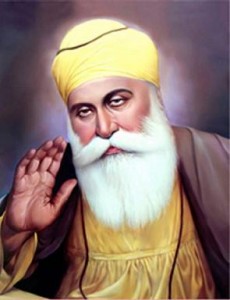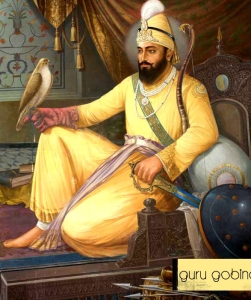By Promod Puri

Guru Nanak Dev and Guru Gobind Singh represent two distinct aspects of Sikhism. In the evolution of Sikhism, together these significant facets symbolize the Khalsa, a saint-soldier designation which is pure, clean, and free.
The saint-soldier image of the Khalsa was initiated by Guru Nanak and got concluded by Guru Gobind Singh, according to historian Gokul Chand Narang in his book “Transformation of Sikhism.”
according to historian Gokul Chand Narang in his book “Transformation of Sikhism.”
 according to historian Gokul Chand Narang in his book “Transformation of Sikhism.”
according to historian Gokul Chand Narang in his book “Transformation of Sikhism.”
He writes: the sword which carved the Khalsa way to glory was undoubtedly forged by Guru Gobind Singh. But the steel had been provided by Guru Nanak, who had obtained it by smelting the Hindu ore and burning out the dross of indifference and superstition of the masses, and hypocrisy and pharisaism (rigid observation of external forms of religion) of the priests.”
It is in the saint-soldier context that if we view serenity and warrior aspects in the Sikh psyche, then we can learn Sikhism in a more discerning manner.
Sikh historian and popular columnist late Khushwant Singh wrote in one of his columns:
“Perhaps the most important issue to be considered by scholars of Sikh theology will be to convince people that there is a continuous and unbroken line between the teachings of Guru Nanak and the first five gurus enshrined in the Adi Granth. And the militant tradition began by the sixth Guru and brought to culmination by the 10th and the last Guru Gobind Singh with the establishment of the Khalsa Panth.”
Whereas, the popular belief that Guru Nanak was a pure saint and Guru Gobind Singh more as a combating fighter, the fact is that both were saints, and both were soldiers. It is a matter of ascertaining them in their own different circumstances and respective periods, which had a gap of 200 years.
Guru Nanak’s teachings were based on the belief in one God, concisely and prudently described in the mool-mantra: He who is undefinable, unborn, immortal, omniscient, all-pervading, and the epitome of truth.
Guru Nanak also spoke against the division of mankind in terms of caste and class. He ridiculed meaningless rituals and customs. In seeking equality, he established the sanctity of the Sangat, a religious meet of devotees. And for the same reason, Guru Nanak instituted the tradition of langar,community eating together without distinction of religion, caste, gender, economic status or ethnicity.
An outstanding feature of Guru Nanak’s philosophy is to realize God while fulfilling domestic obligations. He emphasized work as a moral duty.
His message is simple: “kirt karo, vand chhako, naam japo.” Translation: work, share what one earns, and take the name of God.
When Guru Nanak emphasized that God’s realization can be obtained not by running away from worldly and domestic problems, rather by facing and tackling them in righteous and honest ways, then that is the real challenge and real struggle.
In this battle, a soldier is born within.
Guru Nanak certainly sowed the seed to fightback life’s continuous hardships, struggles, injustices, immoral rituals, inequality, and racism. Sikhism upholds the dignity of man and labor.
Guru Nanak believed in practical religion which involves work and spirituality going not at separate times, but together all the time.
Sikhism does not believe in the practice of religion in isolation from the worldly pursuits.
Ninth Guru Teg Bahadur says:
Kahe re ban khojan jayee,
Sarab niwasi sada alaipa
Tahi sang samayie
Pope madh jyo baas bast hai
Mukr main jaisse chayee
Taise hi har basse nirantar
Ghut hi khojo bhai.
(Oh man why go to the forest
In search of god,
A family man is always pure,
And the God dwells in him
Just like fragrance stays in flower,
Reflections appear in the mirror.
Similarly, God prevails in the heart
Of family man.
Therefore, find God within yourself.)
In the confronting history of Sikhism, its followers and subsequent Gurus faced extreme challenges not only to survive but upkeep the spirit and message of their founder, Guru Nanak Dev.
Khushwant Singh writes:
“There can be little doubt that the martyrdom of Guru Arjun in 1606 resulted in a radical change in the community outlook. Though its creed remained wedded to the Adi Granth, it was ready to defend itself by use of arms. Guru Arjun’s son, the sixth Guru, Har Gobind, raised a cavalry of horsemen. He built the Akal Takht facing the Harmandir as the seat of temporal power and came to be designated Miri Piri Da Malik (Lord of temporal and spiritual power). For some years he was imprisoned in Gwalior fort. The final transition came after the execution of the ninth Guru, Tegh Bahadur, in 1675. His son, Guru Gobind, justified the transition in a letter, Zafarnamah, said to have been addressed to Emperor Aurangzeb: When all other means have failed, it is righteous to draw the sword’. Guru Gobind’s concept of God underwent a martial metamorphosis.”
When Guru Gobind Singh came on the horizon which was in the climax of the militant struggles of the preceding Gurus, including the martyrdom of Guru Arjun Dev and execution of Guru Teg Bahadur, it was a noticeable emergence of the saint-soldier ideology in Sikhism.
The 10th Guru Gobind Singh inherited this ideology from Guru Nanak’s emancipation from superstition and hypocrisy. Guru Angad’s campaign against drifting into asceticism and aimlessness in life. Guru Ram Das’ extension of the power and influence of the sect. Guru Arjan’s transformation of the community into a theocratic society by giving it a code, a capital, a treasury, and a chief in the person of the Guru. Guru Har Gobind gave it an organized army, finally the traumatic sacrifice in the execution of Guru Teg Bahadur.
All these phases fall into a continuous line to create the image of saint-soldier Khalsa in Sikhism.
(Promod Puri is a journalist, writer, and author of Hinduism beyond rituals, customs, and traditions. Websites: promodpuri.com, progressivehindudialogue.com,and promodpuri.blogspot.com)
No comments:
Post a Comment